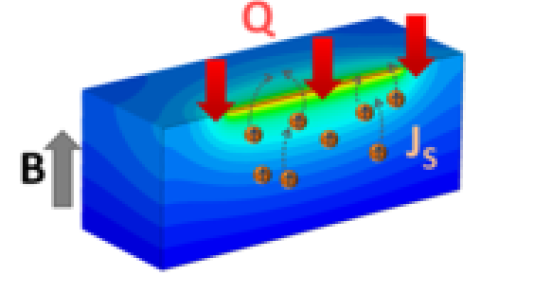
Researchers in Argonne’s Center for Nanoscale Materials and Materials Science Division have found a ferromagnetic material is not necessary to create spin current from insulators. This has important implications for the field of spintronics and the development of high-speed, low-power electronics that use electron spin rather than charge to carry information.
Spin is a quantum property of electrons analogous to a bar magnet that points either “up” or “down.” One method for shrinking electronics is to separate the flow of electron spin from the flow of electron current, and thus carry information through insulators rather than through wires. To create a current of spins in insulators, electrons are typically stationary in a ferromagnetic lattice such as yttrium iron garnet (YIG). Upon application of a heat gradient, information about the orientation of a spin is communicated from one point to another along the lattice. Spin excitations known as magnons have been proposed as the mechanism for carrying the current.
In this study, a layer of ferromagnetic YIG on a substrate of paramagnetic gadolinium gallium garnet (GGG) was studied. No action from the GGG was expected because in a paramagnet the spins aren’t aligned as they are in a ferromagnet; however, the spin current was stronger in the GGG than it was in the YIG. In particular, the longitudinal spin Seebeck effect was observed in paramagnetic insulators. By using a microscale on-chip local heater, a large thermal gradient was generated and confined to the chip surface without a large increase in the total sample temperature. Using this technique at low temperatures (<20 K), the paramagnetic spin Seebeck effect was resolved in the insulating paramagnets Gd3Ga5O12 (gadolinium gallium garnet, GGG) and DyScO3 (DSO), using either W or Pt as the spin detector layer. By taking advantage of the strong magnetocrystalline anisotropy of DSO, contributions from the Nernst effect was eliminated in W or Pt, which produces a phenomenologically similar signal.
This work has important implications for the study of spintronic devices in that ferromagnetic materials may not be necessary; either a paramagnetic metal or a paramagnetic insulator appear to be active as well.
S. Wu et al., “Paramagnetic spin Seebeck effect,” Physical Review Letters, 114, 186602 (2015).